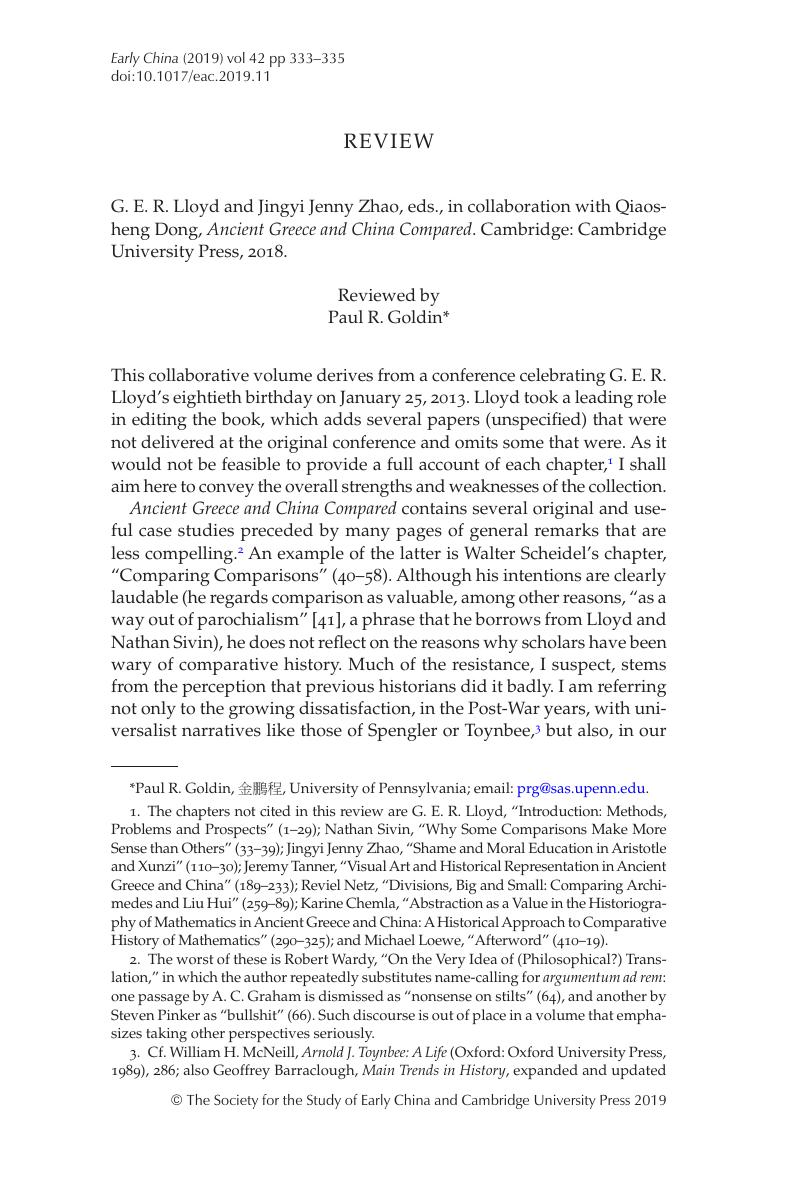No CrossRef data available.
Article contents
G. E. R. Lloyd and Jingyi Jenny Zhao, eds., in collaboration with Qiaosheng Dong, Ancient Greece and China Compared. Cambridge: Cambridge University Press, 2018.
Review products
Published online by Cambridge University Press: 09 October 2019
Abstract

- Type
- Review
- Information
- Copyright
- Copyright © The Society for the Study of Early China and Cambridge University Press 2019
References
1. The chapters not cited in this review are G. E. R. Lloyd, “Introduction: Methods, Problems and Prospects” (1–29); Nathan Sivin, “Why Some Comparisons Make More Sense than Others” (33–39); Jingyi Jenny Zhao, “Shame and Moral Education in Aristotle and Xunzi” (110–30); Jeremy Tanner, “Visual Art and Historical Representation in Ancient Greece and China” (189–233); Reviel Netz, “Divisions, Big and Small: Comparing Archimedes and Liu Hui” (259–89); Karine Chemla, “Abstraction as a Value in the Historiography of Mathematics in Ancient Greece and China: A Historical Approach to Comparative History of Mathematics” (290–325); and Michael Loewe, “Afterword” (410–19).
2. The worst of these is Robert Wardy, “On the Very Idea of (Philosophical?) Translation,” in which the author repeatedly substitutes name-calling for argumentum ad rem: one passage by A. C. Graham is dismissed as “nonsense on stilts” (64), and another by Steven Pinker as “bullshit” (66). Such discourse is out of place in a volume that emphasizes taking other perspectives seriously.
3. Cf. McNeill, William H., Arnold J. Toynbee: A Life (Oxford: Oxford University Press, 1989), 286Google Scholar; also Geoffrey Barraclough, Main Trends in History, expanded and updated by Burns, Michael, as Main Trends in the Social and Human Sciences (New York: Holmes and Meier, 1991), 171Google Scholar.
4. Cf. Kirkland, Russell, “Hermeneutics and Pedagogy: Methodological Issues in Teaching the Daode Jing,” in Teaching the Daode Jing, ed. DeAngelis, Gary D. and Frisina, Warren G., AAR Teaching Religious Studies Series (Oxford: Oxford University Press, 2008), 150–51Google Scholar: “When Westerners encountered the religious and intellectual traditions of Asia, they went about making sense of those traditions by comparing and contrasting what they saw in them with what they ‘knew’ from their own tradition. … Chinese traditions, including the Daode jing, therefore came to be interpreted according to a variety of Western agendas, and any historical or textual facts that could not be made to fit into the interpreter’s agenda were simply ignored or explained away.”
5. “Comparative Philosophy and the tertium: Comparing What with What, and in What Respect?,” Dao 15.2 (2014), 151–71. Scheidel’s perfunctory review of recent work comparing Greco-Roman and Chinese sources ignores several authors, including Jean-Paul Reding, Alexander Beecroft, Samuel N. C. Lieu, and even Lisa Raphals, one of the contributors to this volume.
6. for but one sketch of the possibilities, see Buchman, Daniel et al. , “Interdisciplinary Education and Knowledge Translation Programs in Neuroethics,” in Creating Consilience: Integrating the Sciences and the Humanities, ed. Slingerland, Edward and Collard, Mark, New Directions in Cognitive Science (Oxford: Oxford University Press, 2011), 334–48CrossRefGoogle Scholar.
7. These are Xinyi Liu et al., “From the Harvest to the Meal in Prehistoric China and Greece: A Comparative Approach to the Social Context” (355–72), and Vivienne Lo and Eleanor Re’em, “Recipes for Love in the Ancient World” (326–52). The latter finds that Greco-Roman aphrodisiacs had “overarching reproductive aims” (348), in contrast to those of ancient China, whose purposes included physical self-cultivation.
8. There is one influential article that King does not discuss: Wong, David B., “The Meaning of Detachment in Daoism, Buddhism, and Stoicism,” Dao 5.2 (2006), 207–19CrossRefGoogle Scholar.




